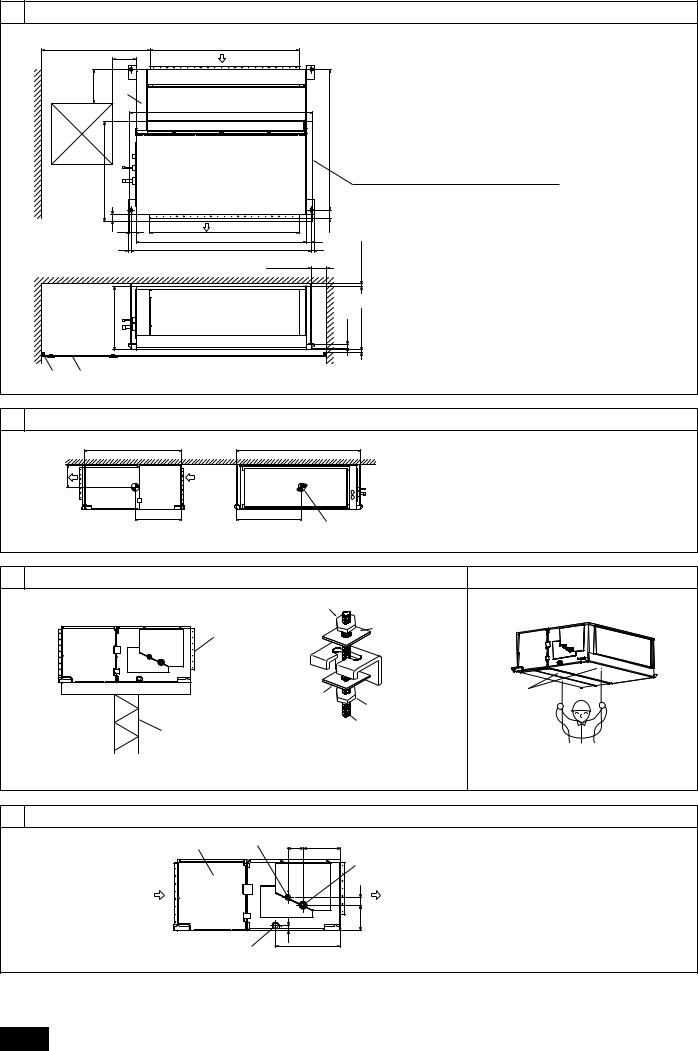Mitsubishi Electronics PEA-RP250 WHA User Manual

Air-Conditioners
INDOOR UNIT
PEA-RP250 WHA
GB
INSTALLATION MANUAL
For safe and correct use, please read this installation manual thoroughly before installing the air-conditioner unit.

3
[Fig. 3.2.1]
800
|
150~200 |
|
~300 |
B |
|
200 |
||
|
450
A
730
50 |
50 |
|
|
|
23 |
470
EA
1100
C
1350
D 1100 1250 1324
3.2
1034
60
37
23
more than 100
Keep the service space for the maintenance from the bottom when the heat exchanger is cleaned.
|
more than 20 |
|
1030± |
20 |
|
thanmore |
A Access door |
|
|
|
B Electrical parts box
C Air inlet
DAir outlet
ECeiling surface
4 |
|
4.1 |
[Fig. 4.1.1] |
1034 |
1324 |
235 |
|
|
|
494 |
701 |
A
A Center of gravity
5 |
5.1 |
[Fig. 5.1.1] |
[Fig. 5.1.2] C |
|
D |
|
A |
|
D |
|
C |
B |
E |
|
|
|
C Nuts (field supply) |
A Unit body |
D Washers (accessory) |
B Lifting machine |
E M10 hanging bolt (field supply) |
5.3
[Fig. 5.3.1]
A
A Indoor unit’s bottom surface
6 |
|
|
|
6.2 |
|
[Fig. 6.2.1] |
D |
B |
|
100 244 |
|
|
|
|
|
C |
|
|
|
|
|
52 |
|
A |
|
|
|
165 |
F |
|
|
|
|
|
|
|
|
|
30 |
424 |
|
|
|
|
|
|
E
A Air inlet |
B Refrigerant piping (liquid) |
||
C |
Refrigerant piping (gas) |
D |
Control box |
E |
Drain pipe |
F |
Air outlet |
2

7 |
7.1 |
[Fig. 7.1.1] |
[Fig. 7.1.2] |
A Cut here
B Remove brazed cap
[Fig. 7.1.3]
A
B
C
E
 D M P
D M P
N
G  O
O
F
I  M
M
J  H
H
K

|
20 |
E |
|
|
|
|
|
20 |
|
Q |
R |
|
|
|
K
 L
L
20
20 J
 A
A
A Cool by a wet cloth
AThermal insulation tubing (small)
BCaution:
Pull out the thermal insulation on the refrigerant piping at the site, braze the piping, and replace the insulation in its original position.
Take care to ensure that condensation does not form on exposed copper piping.
CRefrigerant piping (liquid)
DRefrigerant piping (gas)
EMain body
FThermal insulation tubing (large)
GSite refrigerant piping
HEnsure that there are no gaps between the insulation and the main body.
IThermal insulation tubing (small) (supplied) 1
JTies (large) (supplied) 4
KEnsure that there is no gap here. Place join upwards.
LThermal insulation tubing (medium) (supplied) 2
MThermal insulation
NPull
OFlared pipe end
PWrap with damp cloth
QReturn to original position
REnsure that there is no gap here.
7.2
[Fig. 7.2.1]
|
C |
C |
C |
A Downward slope 1/100 or more |
|
|
|
E |
B Drain hose (Accessory) |
A |
|
|
C Indoor unit |
|
|
|
|
||
B |
1 |
|
|
D Collective piping |
|
|
|
|
|
|
D |
|
2 |
E Maximize this length to approx. 10 cm |
|
|
|
[Fig. 7.2.2]
|
|
I |
|
A |
B |
F |
G |
|
5 |
25 |
H |
|
D |
E |
|
C
AIndoor unit
BInsulation pipe (short) (accessory)
CTie band (accessory)
DBand fixing part
EInsertion margin
FDrain hose (accessory)
GDrain pipe (O.D. ø32 PVC TUBE, field supply)
HInsulating material (field supply)
IMax.145 ± 5 mm
3

8
[Fig. 8.0.1]
|
D |
|
|
D C |
C |
|
|
|
|
B |
|
|
|
|
A |
I |
|
|
H |
|
E G |
F |
||
|
|
|
||
|
A Air inlet |
B Air filter (supplied at site) |
|
|
|
C Duct |
D Canvas duct |
|
|
|
E Access door |
F Ceiling |
|
|
GEnsure sufficient length to prevent short cycling
H Air outlet I Keep duct-work length 850 mm or more
9 |
9.1 |
|
|
|
9.2 |
|
[Fig. 9.1.1] |
|
[Fig. 9.2.1] |
|
B |
A |
|
|
|
|
|
|
||
|
|
|
|
M1M2 |
M1M2 S 1 |
2 |
|
|
|
TB3 |
|
TB5 |
TB15 |
|
|
|
|
|
|
A Terminal block for indoor |
A |
B |
|
|
|
|
transmission cable |
|
|
|
|
|
|
B Terminal block for outdoor |
|
C |
|
|
|
|
transmission cable |
|
|
|
|
|
C Remote controller |
|
|
|
|
|
|
|
|
|
|
[Fig. 9.2.2] |
|
|
|
|
|
|
|
|
B |
|
C |
A Switch 16 A |
|
D |
|
2 |
|
|
|
|
A |
|
|||
B Overcurrent protection 16 A |
|
|
1 |
|
||
|
|
|
|
|||
C Indoor unit |
|
|
|
S |
|
|
|
|
|
M2 |
|
|
|
|
|
|
|
|
|
|
|
|
|
|
M1 |
|
A Non-polarized |
|
|
|
|
DC10~13V |
B TB15 |
|
|
|
|
|
|
C |
|
|
|
|
N |
|
C Remote Controller |
|
|
|
L |
A |
B |
||
|
|
|
|
|||
|
|
|
1 |
2 |
D TB5 |
|
|
|
|
|
|||
|
|
|
|
|
|
|
4
